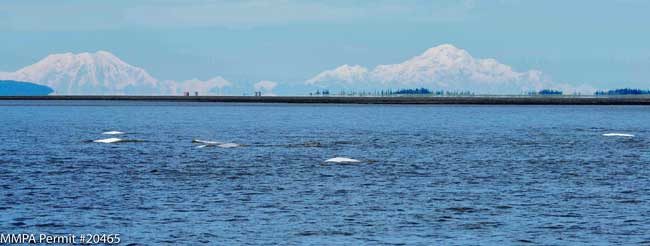
For the first time, we are using an Unmanned Aerial System (UAS), a hexacopter, to collect photographs of the endangered Cook Inlet beluga whale to estimate the length of individual whales and learn more about why it has been slow to recover despite many efforts to help it.
The Cook Inlet watershed stretches some 50,000 square miles. At its mouth is the most populated city in Alaska, Anchorage, Alaska. As a result, the inlet is a pretty busy place.
Over the course of two weeks, I am working with partners from NOAA Fisheries Southwest Fisheries Science Center and the Alaska Department of Fish and Game (ADFG) to carry out this important survey.
We are using length to help us determine whether the whales observed are adults, juveniles, or calves. Beluga whales give birth fairly synchronously, starting in late July and finishing by September. By doing hexacopter photography surveys each year in late August or early September, we hope we can monitor calf production and compare that to environmental factors, such as the strength of salmon runs in a given year. Salmon are an important food source for beluga whales in the inlet. We will also be trying to identify individual whales from both aerial and other collected photographs. Through photographs, we can also learn more about whale injuries and disease.
Collecting information on birth and death rates, disease and general condition may help us better understand why the beluga whale population in this area isn’t doing better.
Project Partners
John Durban from the Southwest Fisheries Science Center has provided a hexacopter flight team of two NOAA Corp officers, LTJG Hollis Europe and LTJG Jake Barbaro. We are operating on an ADFG 21′ Safeboat piloted by Justin Jenniges, Tom Gage, or Ryan Morrill. Dave McKay is helping us navigate Cook Inlet’s mud flats and 30 foot tides.
We’re grateful for the help of Tamara McGuire, Principle Investigator of the Cook Inlet Beluga Whale Photo-ID Project (https://www.cookinletbelugas.com), who graciously shared her experiences working in small boats in the upper Cook Inlet and her knowledge of the whales, gained over the last 10 years working with her core team of Amber Stephens, Brad Goetz, and Alana Summerlin. Her help was invaluable. Finally, we want to thank the great local support we are getting from Mandy Migura, Cook Inlet Beluga Whale Recovery Coordinator, and Greg Balogh, at the NOAA Fisheries Alaska Regional Office in Anchorage.
More about Cook Inlet Beluga Whales
The Cook Inlet beluga whale is a genetically distinct population that declined rapidly in the 1990s, and continued to decline more slowly in the 2000s, resulting in it being listing as an Endangered species.
In 2016 NOAA Fisheries included the Cook Inlet beluga whale as one of eight Species in the Spotlight (SIS), species at high risk needing immediate, targeted efforts to stabilize their population and prevent extinction. (https://www.fisheries.noaa.gov/stories/2015/05/spotlight_cook_inlet_beluga_whale.html). NOAA Fisheries Species in the Spotlight Initiative has provided resources to support this new research.
Meet the Blogger
 Paul Wade Photo by: Justin Jenniges (ADF&G) |
Paul Wade is a Research Fisheries Biologist at NOAA Fisheries’ Alaska Fisheries Science Center’s Marine Mammal Laboratory and project lead.
Paul joined the Lab’s Cetacean Assessment and Ecology Program in 1996, after completing a Ph.D. at Scripps Institution of Oceanography, and a NRC Postdoctoral Fellowship at the Southwest Fisheries Science Center. He has conducted killer whale research in the Aleutian Islands since 2001, and recently took over as head of Cook Inlet Beluga Whale research for the Lab.[xyz-ihs snippet=”Adsense-responsive”]
